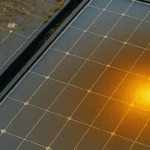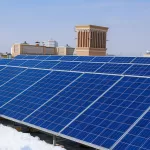1. Pressure on Corporate Energy Consumption Under Summer Peak Electricity Prices
In recent years, summer energy expenditures have climbed almost every year, becoming a cost pressure that many European companies can no longer ignore. Commercial air conditioning, cold-chain equipment, ventilation systems, and automated production lines run continuously during the day, representing the main sources of high-intensity electricity loads for businesses.
In major markets such as Germany and Italy, the unit price of electricity for commercial users between 11:00 and 16:00 often exceeds €0.30 per kWh, 40% to 100% higher than the base rate. Some company leaders have even reported that over the past two summers they have clearly felt the impact of air-conditioning electricity costs on their financial statements, especially those with heavy daytime loads—precisely the businesses most in need of cost reduction.
What truly drives costs skyward is not just the electricity price itself, but the disconnect between corporate consumption patterns and electricity pricing mechanisms. Once pricing is detached from actual load, companies cannot adjust their usage rhythm and must bear ever-higher unit costs, squeezing profit margins.
Faced with this structural imbalance, should companies continue to passively absorb peak-time electricity costs, or start considering the possibility of active peak shaving?
For many enterprises, peak shaving is no longer merely an optional energy-saving measure but a crucial factor increasingly shaping energy structure and budget stability. Industrial and commercial photovoltaic systems—with their load-offsetting capabilities—are being added to the medium- to short-term energy strategy evaluation lists of more and more companies.

2. How Photovoltaic Systems Drive Savings During High‐Price Periods
Reducing unit energy costs without altering production rhythms has become a priority in many companies’ energy strategies.
The value of commercial photovoltaic systems lies not only in their low generation cost but in the strong alignment between their output curve and peak electricity prices, providing a natural load‐offsetting capability.
In most European countries, the peak generation period for industrial and commercial PV systems falls between 11:00 and 15:00, almost perfectly overlapping with commercial tariff peaks. Under a self‐consumption model, PV generation is prioritized for on‐site use, directly replacing the highest unit‐cost grid purchases. It is this temporal overlap that delivers predictable cost savings.
As an illustrative calculation, if a company’s average midday load is 250 kWh and its PV system covers 180 kWh of that, at a peak rate of €0.32/kWh the daily savings amount to approximately €57. Over three months, this accumulates to nearly €5,000. With the addition of energy storage or load scheduling, savings potential can increase by 10 %–20 %.
The stability of these savings also depends on module performance under high‐temperature conditions. Roof surface temperatures often exceed 60 °C in summer, and differences in temperature‐related power degradation among module technologies directly affect peak‐period output.
For example, PERC modules have a temperature coefficient of –0.35 %/°C, resulting in over 14 % power loss when module temperature rises from 25 °C to 65 °C. In contrast, TOPCon modules rate –0.32 %/°C, while IBC modules improve further to –0.29 %/°C and offer higher conversion efficiency (over 23 %). These technologies maintain stronger output stability in heat, making them especially suitable for hot, high‐price summers.
In scenarios with flexible loads or coupled storage units, commercial PV systems can extend savings by increasing self‐consumption—shifting noncritical loads into PV peak hours or using stored energy to cover evening demand. This mechanism embeds a controllable adjustment logic between energy supply and price fluctuations, enabling companies to better manage price volatility and budget forecasts.
Summer PV Cost Savings Calculation Table
| Metric | Value | Description |
|---|---|---|
| Midday Electricity Load | 250 kWh | Total consumption between 11:00 and 15:00 each day |
| PV Coverage | 180 kWh | Energy supplied by the PV system during the same period |
| Load Coverage Ratio | 72% | Proportion of midday load met by PV |
| Peak Tariff | 0.32 €/kWh | Typical commercial rate in Germany/Italy; adjust as needed |
| Daily Electricity Cost Savings | €57.60 | = 180 × 0.32 |
| Total Summer Savings (88 days) | €5,069 | Estimated based on typical summer duration |
Note: Pairing with energy storage or optimizing load scheduling can increase savings potential by 10%–20%.
3. Real-World Scenarios for Peak Shaving and Cost Savings Calculation
The cost-saving potential of industrial and commercial PV systems depends on how well a company’s consumption profile aligns with peak electricity tariffs, rather than on the system’s nameplate capacity alone.
Under conditions where loads are concentrated during daytime and peak tariffs significantly exceed off-peak rates, a self-consumption PV model delivers clear savings. Operations such as cold-chain processing, refrigerated storage, and automated logistics—due to continuous daytime temperature control and power demands—are typical beneficiaries of this approach.
For example, at a cold-chain processing facility in northern Italy, the average midday (11:00–15:00) load is 300 kWh, of which 200 kWh is consistently covered by the PV system. At a peak tariff of €0.28 /kWh, the company saves €56 per day, totaling approximately €5 040 over a three-month summer period. With co-located storage or load-shifting strategies, savings can increase by 10 %–20 %, further enhancing on-site utilization of PV generation.
Compared to traditional full-export models, self-consumption offers more predictable savings, transforming the PV installation from a “generation investment” into a “price-risk management” tool.
Savings are directly tied to the company’s own purchase price rather than feed-in tariffs, resulting in shorter payback periods and more controllable cash flow
By using self-generated PV electricity, companies reduce dependence on external price fluctuations, making operating costs more predictable
Compressing peak-period loads and increasing renewable share can boost a company’s energy rating and ESG compliance scores
As green tax incentives and carbon border adjustment mechanisms come into effect, PV systems will not only conserve energy but also become part of a company’s compliance framework
Beyond financial benefits, self-consumption PV systems deliver long-term value. In certain industries, commercial PV is already regarded as a stable, yield-generating asset on the balance sheet.

4. How Businesses Can Determine Their Suitability for PV System Installation
Not all companies will immediately realize cost savings upon deploying a PV system. Scenarios with true peak‐shaving potential tend to align with specific tariff structures and load profiles, especially during the summer peak season.
For companies aiming to curb energy expenditures during seasonal price spikes, assessing “PV suitability” requires focusing on three key variables:
For businesses with sustained loads during midday peak hours (11:00–15:00), such as cold‐chain, air‐conditioning, or automated production lines, PV generation precisely covers the most expensive consumption periods.
Roof availability and rapid deployability are also critical. A structurally sound, clearly owned, and unobstructed rooftop enables fast project implementation.
Local tariff mechanisms serve as a judgment criterion. If peak rates exceed €0.25/kWh and time‐of‐use pricing applies, PV can directly offset the costliest consumption window.
When a company meets all three conditions—concentrated peak load, usable rooftop, and high price exposure—it enters a deployment window where savings can be realized within the current quarter. Whether via self‐investment, direct build, leasing, or a PPA model, a PV system will deliver tangible peak‐shaving benefits under the present tariff structure. For budget‐limited enterprises, a zero‐investment rooftop lease can provide a rapid alternative, enabling swift conversion to a savings model.
If these conditions are not yet met, it is recommended to first optimize load scheduling, site readiness, or financing capacity to avoid misaligned deployment pacing that could jeopardize expected returns.
It is worth noting that in parts of Europe, summer commercial peak rates have exceeded €0.30/kWh for consecutive years. For companies with high daytime load shares, even a PV system covering basic consumption can yield quarterly savings in the thousands of euros. These savings do not rely on subsidies or future price trends but solely on the rapid alignment of existing infrastructure and technology.
Peak shaving need not take years to materialize; with proper deployment, price pressures can be alleviated this quarter. For eligible businesses, deploying now and realizing savings immediately represents a rare, time‐limited opportunity.
Since 2008, Maysun Solar has been both an investor and manufacturer in the photovoltaic industry, providing zero-investment commercial and industrial rooftop solar solutions. With 17 years in the European market and 1.1 GW of installed capacity, we offer fully financed solar projects, allowing businesses to monetize rooftops and reduce energy costs with no upfront investment. Our advanced IBC, HJT and TOPCon panels, and balcony solar stations, ensure high efficiency, durability, and long-term reliability. Maysun Solar handles all approvals, installation, and maintenance, ensuring a seamless, risk-free transition to solar energy while delivering stable returns.
References
Eurostat. (2023). Electricity prices for non-household consumers, first half 2023. Statistical Office of the European Union.
https://ec.europa.eu/eurostat/databrowser/view/nrg_pc_205/default/table
Fraunhofer Institute for Solar Energy Systems ISE. (2023, November). Photovoltaics Report 2023. https://www.ise.fraunhofer.de/en/publications/studies/photovoltaics-report.html
International Renewable Energy Agency (IRENA). (2023, December). Renewable Power Generation Costs in 2023. Abu Dhabi: IRENA. https://www.irena.org/publications
PV Magazine. (2024, January). Commercial and industrial solar: Trends and challenges in Europe. PV Magazine Europe. https://www.pv-magazine.com/category/markets-policy/
Federal Ministry for Economic Affairs and Climate Action (BMWK). (2023, March). Electricity price relief measures for businesses in Germany. https://www.bmwk.de/
Recommend Reading

Structural Risks and Component Adaptation Strategies for Commercial PV Deployment under Extreme Weather Conditions
A comprehensive analysis of the structural risks and component configuration strategies for commercial and industrial PV systems under extreme weather conditions, helping businesses enhance system stability and long-term energy yield.

How Can Photovoltaics Help Businesses Cut Peak Electricity Costs During Summer Price Spikes?
How Can Businesses Use Photovoltaic Systems to Address Summer Electricity Price Peaks? This article provides cost-saving calculations, suitability conditions, and technical selection recommendations.

How to Detect Hotspots and PID Effects in PV Modules to Prevent Long-Term Losses?
How to identify and respond to hotspots and PID effects in PV modules? This article focuses on the European market, combining detection technologies, real-world cases, and protection strategies to provide developers and investors with reliable loss warnings and yield protection solutions.

How to Choose the Most Suitable Solar Panels for Commercial and Industrial Use in 2025
How can commercial and industrial projects choose the right solar panels in 2025?
This article provides a systematic comparison of mainstream panel types such as TOPCon, HJT, and IBC, analyzing their advantages, disadvantages, and suitable applications. It aims to help businesses make accurate selections based on specific project conditions, thereby improving long-term energy output and return on investment.

After the Iberian Blackout How Can Enterprises Reshape Their Energy Security Systems
The 2025 Iberian blackout drew widespread attention across Europe. This article analyzes grid vulnerability, enterprise energy risks, and the deployment path of “solar + storage + EMS” systems to help businesses build a controllable and secure energy structure.

Photovoltaic Fire Safety Guide: How to Reduce the Risk of Power Plant Fires?
The risk of fire in photovoltaic power plants is on the rise. This article, based on European policy standards, provides a detailed explanation of design optimization, operation and maintenance strategies, and emergency response measures to enhance fire safety levels.



